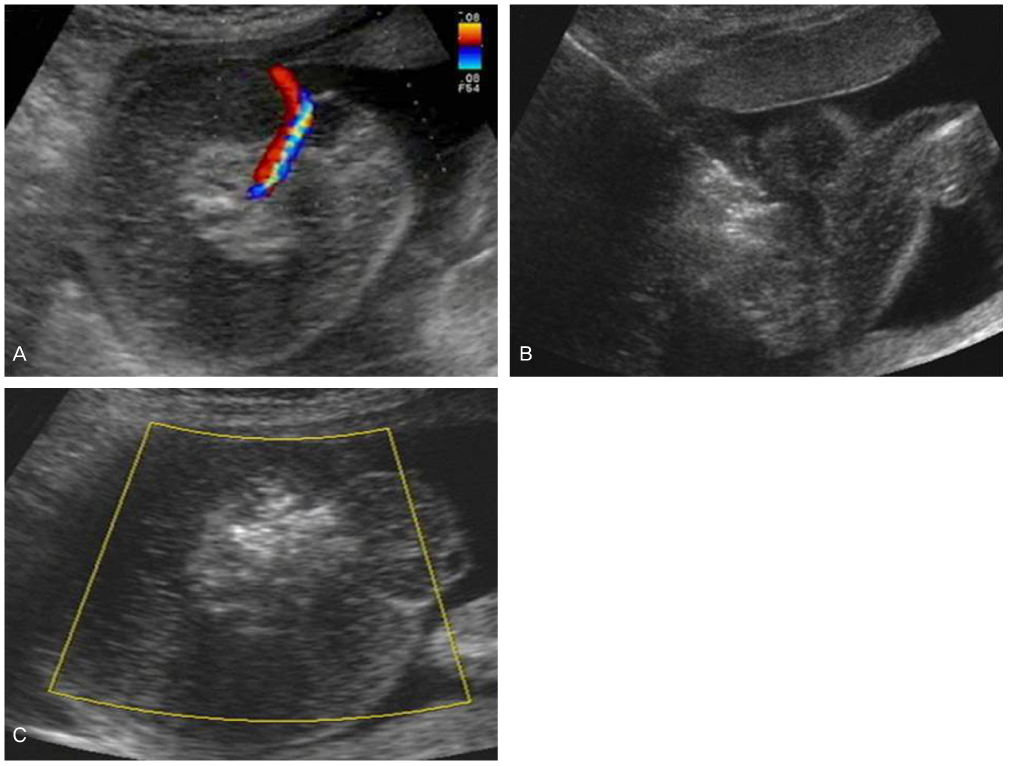Korean J Obstet Gynecol.
2012 Aug;55(8):552-558. 10.5468/KJOG.2012.55.8.552.
Perinatal outcome of twin reversed arterial perfusion sequence: A single center's experience
- Affiliations
-
- 1Department of Obstetrics and Gynecology, Asan Medical Center, University of Ulsan College of Medicine, Seoul, Korea. hswon@amc.seoul.kr
- KMID: 2078104
- DOI: http://doi.org/10.5468/KJOG.2012.55.8.552
Abstract
OBJECTIVE
To report our experience of using radiofrequency ablation (RFA) to treat fetuses diagnosed with twin reversed arterial perfusion (TRAP) sequence and to evaluate the perinatal outcome of pump twins.
METHODS
Twenty-six fetuses diagnosed with the TRAP sequence were retrospectively analyzed between July 1998 and September 2011 at Asan Medical Center. Four were lost to follow-up after diagnosis and, therefore, were excluded from further evaluation. The perinatal outcomes of pump twins were evaluated by reviewing the medical records.
RESULTS
Twenty-two fetuses were diagnosed with the TRAP sequence during the study period, including 15 monochorionic-diamniotic pregnancies and four monochorionic-monoamniotic pregnancies. Three patients had triplet pregnancies. The median gestational age at diagnosis was 17.4 weeks (range, 11.0 to 27.0 weeks). Of these 22 cases, in utero RFA was performed in 11 (50%), alcohol ablation in one (4.5%) and the remaining 10 (45.5%) underwent conservative management. The median gestational age at in utero intervention was 21.0 weeks (range, 17.6 to 25.0 weeks). The overall neonatal survival rate was 77% (17 of 22). The median gestational age at delivery was 37.3 weeks (range, 30.2 to 40.1 weeks). All of the surviving infants are doing well without any complications.
CONCLUSION
For fetuses with the TRAP sequence, proper in utero treatment with RFA enables to continue the pregnancy with a good prognosis.
Keyword
MeSH Terms
Figure
Reference
-
1. James WH. A note on the epidemiology of acardiac monsters. Teratology. 1977. 16:211–216.2. Van Allen MI, Smith DW, Shepard TH. Twin reversed arterial perfusion (TRAP) sequence: a study of 14 twin pregnancies with acardius. Semin Perinatol. 1983. 7:285–293.3. Moore TR, Gale S, Benirschke K. Perinatal outcome of forty-nine pregnancies complicated by acardiac twinning. Am J Obstet Gynecol. 1990. 163:907–912.4. Quintero RA, Chmait RH, Murakoshi T, Pankrac Z, Swiatkowska M, Bornick PW, et al. Surgical management of twin reversed arterial perfusion sequence. Am J Obstet Gynecol. 2006. 194:982–991.5. Hecher K, Lewi L, Gratacos E, Huber A, Ville Y, Deprest J. Twin reversed arterial perfusion: fetoscopic laser coagulation of placental anastomoses or the umbilical cord. Ultrasound Obstet Gynecol. 2006. 28:688–691.6. Scheier M, Molina FS. Outcome of twin reversed arterial perfusion sequence following treatment with interstitial laser: a retrospective study. Fetal Diagn Ther. 2012. 31:35–41.7. Lee H, Wagner AJ, Sy E, Ball R, Feldstein VA, Goldstein RB, et al. Efficacy of radiofrequency ablation for twin-reversed arterial perfusion sequence. Am J Obstet Gynecol. 2007. 196:459.e1–459.e4.8. Tan TY, Sepulveda W. Acardiac twin: a systematic review of minimally invasive treatment modalities. Ultrasound Obstet Gynecol. 2003. 22:409–419.9. Tsao K, Feldstein VA, Albanese CT, Sandberg PL, Lee H, Harrison MR, et al. Selective reduction of acardiac twin by radiofrequency ablation. Am J Obstet Gynecol. 2002. 187:635–640.10. Livingston JC, Lim FY, Polzin W, Mason J, Crombleholme TM. Intrafetal radiofrequency ablation for twin reversed arterial perfusion (TRAP): a single-center experience. Am J Obstet Gynecol. 2007. 197:399.e1–399.e3.11. Jelin E, Hirose S, Rand L, Curran P, Feldstein V, Guevara-Gallardo S, et al. Perinatal outcome of conservative management versus fetal intervention for twin reversed arterial perfusion sequence with a small acardiac twin. Fetal Diagn Ther. 2010. 27:138–141.12. Lee SW, Lee SO, Park MH, Kim YJ, Chun SH, Ahn JJ, et al. Successful management with intra-abdominal alcohol ablation of acardiac twin and amniodrainage in twin reversed arterial perfusion sequence with severepolyhydramnios. Korean J Obstet Gynecol. 2004. 47:1394–1399.13. Jang JH, Moon MJ, Park HR, Ahn EH, Jung SH, Lee YM, et al. Case reports A case of acardiac twin pregnancy with fetus survival after successful radiofrequency ablation of umbilical cord. Korean J Obstet Gynecol. 2010. 53:449–454.14. Wong AE, Sepulveda W. Acardiac anomaly: current issues in prenatal assessment and treatment. Prenat Diagn. 2005. 25:796–806.
- Full Text Links
- Actions
-
Cited
- CITED
-
- Close
- Share
- Similar articles
-
- A case of acardiac twin pregnancy with fetus survival after successful radiofrequency ablation of umbilical cord
- Anesthesia for Fetal Surgery: Twin Reversed Arterial Perfusion Sequence
- Prenatal Diagnosis of TRAP sequence: A Case REport -Usefulness of Color Doppler Sonography-
- Successful Management with Intra-abdominal Alcohol Ablation of Acardiac Twin and Amniodrainage in Twin Reversed Arterial Perfusion Sequence with Severe Polyhydramnios
- Prenatal Diagnosis of Acardiac Twin : A Case Report


